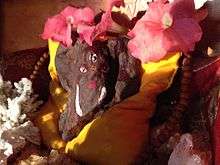Swayambhu
Svayambhu is a Sanskrit word that means "self-manifested" or "that which is created by its own accord". In Tbetan language, this word appears as "Rangjung" རང་བྱུང་ .
Often, the word swayambhu is used to described a self manifested murti.(Sanskrit) or ku (Tibetan) which was not made by human hands, but instead is self manifested, or generated by nature. Rangjung in Tibetan and probably as much in Dzongkha expresses the concept of a self-arisen manifestation. All over the Tibetan cultural sphere there are sacred seed syllables, mantras or depiction of deities that a presumed not to be man-made, but "rangjung", self arisen or autogenic. For example, in the Jokhang Temple in Lhasa is a rangjung goats head in a side chapel protruding out of a big rock.

Vaishnavism
Based on details in Bhagavata Purana and Matsya Purana, Narayana or Krishna is said to be the self-manifested svayambhu form of Brahman as the first cause of creation. (See Hiranyagarbha)
The Ice Lingam at Amarnath Cave
Inside the 40 m (130 ft) high Amarnath cave, the stalagmite is formed due to freezing of water drops that fall from the roof of the cave on to the floor and grows up vertically from the cave floor.[4] It is considered to be a Shiva Linga by Hindus. The Cave waxes during May to August, as snow melts in the Himalayas above the cave and the resultant water seeps into the rocks that form the cave and gradually wanes thereafter.[1] As per the religious beliefs, it has been claimed that the lingam grows and shrinks with the phases of the moon reaching its height during the summer festival, although there is no scientific evidence for this belief.[5]
See also
References
1 "Amarnathji Yatra - a journey into faith". Official Web Site of Jammu and Kashmir Tourism. 4 "Stalactites and Stalagmites - Cave, Water, Caves, and Growth - JRank Articles". Science.jrank.org. Retrieved 2013-04-15. Jump up ^ Ortner, Jon. 5 On the road again. PDN Gallery.